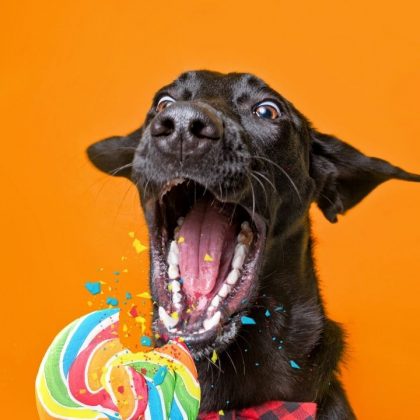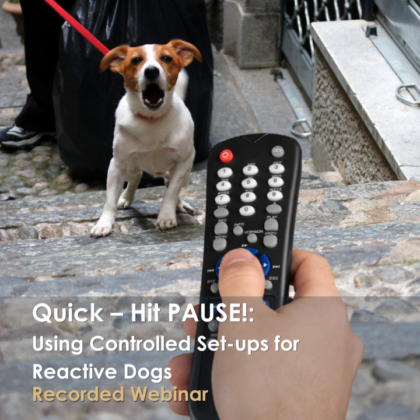While most of us recognize the dog who has been pushed past a threshold and into reaction, it is harder to know exactly where the sweet spot is, the place where learning and thinking occur, where choices are possible, and where behavior changes (good ones!) can happen.
Understanding the Stimulus Gradient (SG) helps handlers recognize a threshold and make good decisions in any situation. Thoughtfully applied, the SG can make it much easier to keep a dog progressing without pushing him too hard (over-threshold), and help a handler understand what went wrong if a mistake occurs — and thus know how to adjust for success. The SG can also help a handler avoid spinning their wheels by working under-threshold to such a degree no real learning occurs.
Whether over-stimulated or afraid or even seriously aggressive, the how of working with reactive dogs is based on appropriate use of the Stimulus Gradient.
There are 3 elements to the Stimulus Gradient (SG):
- Distance (or Proximity) Literally, how far away from the dog is the stimulus that he’s reacting to? This might be another dog, birds, a cat, children running, a biker, a noise. Be precise in marking the distance, so that as you change the distance, you are aware of it and know how it affected the dog. Surprisingly small changes can give you surprisingly different responses. When you get within 20′ or so, consider distances in terms of the dog’s body length. Being 10′ away from a Saint Bernard may only represent 3 body lengths for him, but it might be 10 body lengths for the Toy Manchester Terrier. As with any element of the SG, know the distance so you can adjust up or down with some precision.
- Duration This is a time measurement – for how long will the dog be asked to deal with the stimulus? Will it appear only briefly, or be there for 3 minutes or 30 minutes or an hour or all day? Have a specific time frame in your mind, and work with it. Example: I will present stimulus X for a count of 1-2-3 and then it is gone. That specificity helps me be clear when I decide to increase or decrease the duration.
- Intensity How intense is the stimulus? One cat sitting quietly is much lower intensity than 24 cats practicing their RiverDance routine. The individual dog’s sensory preferences can make something very intense for him while another dog might not find it as intense. Be sure you know how the dog prioritizes sensory input and what affect it has on him; this will help you evaluate the intensity of any given stimulus. Example: a visually sensitive dog might find a raised arm to be a very intense gesture, where a less visually sensitive dog might not react until you ran past.
These 3 elements need to be juggled and adjusted with care & deliberate awareness of what effect any combination will have on the dog. When the balance is right, the dog can handle the situation without “losing it”, can learn and improves (sometimes rapidly) in that setting. The dog “losing it” tells you that you’ve blown it and pushed the dog past his threshold.
What is an appropriate distance? Ideally, the dog is in the Think & Learn Zone meaning he can split his attention between the stimulus and on his handler. If the dog’s attention is focused solely on the stimulus, no training can be accomplished, and you may trigger unwanted behavior or reactions. If the dog’s attention isn’t on the stimulus, no reaction occurs — but neither does any learning about that stimulus. It’s certainly sub-threshold, but it’s also useless.
How long will you expose the dog to the stimulus? A good rule of thumb is not long! Many trainers work not only too close, but expect way too much in the way of duration. The ideal duration is one that leaves the dog just about as relaxed as he was prior to the presentation of the stimulus. Or looked at another way, ideal duration means that the dog is able to very quickly settle once the stimulus is removed.
Ideal duration depends heavily on distance and intensity. It might be only seconds. Again, seeing one cat sitting quietly 100′ away would be something a dog would be able to handle for longer than seeing 24 cats tap dancing as a group 10′ away. When in doubt, use brief duration exposures to the stimulus, and evaluate what the dog tells you. If the dog is slow to settle or completely loses his ability to be responsive to the handler, the duration (and/or intensity and/or distance) was too much.
Intensity is the easiest to vary, and by the same token, one that trainers often underestimate. Some hints when considering intensity:
- Think in very thin slices when adjusting intensity – consider details closely
- For example, a dog sitting with his back is less intense than a dog sitting with his side facing you, which is less intense that a dog laying down facing you
- Speed of movements affects the intensity. Too fast obviously can increase intensity. But be aware that too slow can be very intense and upsetting for some dogs
- Increase distance and decrease duration if you increase intensity
Basic guidelines
- When you change one element, lighten up the other two.
- Strengthen each independently before beginning to combine them.
- For each change, drop back to known success level (or even easier than that).
- Always give the dog the benefit of the doubt.
- Always make things easier if needed so the dog succeeds
- Avoid saying “just one more time”
- End it while it’s good and the dog is successful – avoid waiting till the dog says he can’t handle any more
When unsure:
INCREASE Distance
and
DECREASE Duration & Intensity
Know what you’re doing with all 3 elements of the Stimulus Gradient, and you can help reactive dogs learn new ways to think and respond.
Want to learn more?
Check out the webinar QUICK Hit Pause: Controlled set-ups for Reactive Dogs – If you’ve ever wished for a PAUSE button on life to help your dog, this webinar is for you. The practical information provided will help anyone create successful training moments. Find out why so many clients and their dogs have benefited from this sensible approach to thin slicing for success.


